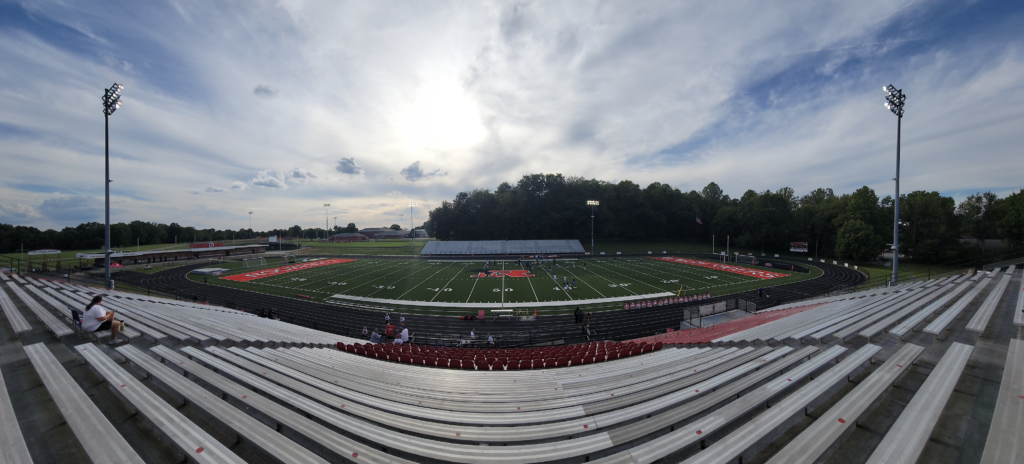Origins of Portage County’s football stadiums
Share

Kent Roosevelt High School stadium became the fifth in Portage County to have turf, following avenna (1999), Aurora (2004), Streetsboro (2017) and Mogadore (2019), respectively.
Roosevelt Stadium remains one of the few in Ohio to have a concrete bleacher structure.
Tom Nader/Portage Sports
By Tom Nader
Publisher and Editor
A football stadium can hold a special place in your heart.
Simply because of some bleachers and a large patch of grass, people from all over your community gather for a few hours to be together.
An example of the power of sports.
That it can bring people together and it can ignite friendships amongst families that span generations.
When the stadium lights are on, they shine across tree tops and radiate to township and city backroads like a lighthouse’s beacon of light for the lost.
You know when those lights are on, that a healthy part of the community is together — supporting each other.
Ever wonder the story behind your hometown stadium? Or its history?
Here are the interesting facts and stories about your special place.
AURORA
Veterans Stadium
Capacity: 5,200
Year Built: 1964
History: The stadium was named in honor of all military veterans and was dedicated on Aug. 27, 2004. The name change was introduced with the stadium’s first year to have turf. Aurora’s field was the second stadium in Portage County to have turf, following only Ravenna, which had turf beginning with the 1999 season.
The stadium has always been in the same location, but was previously known as Aurora Stadium up until the re-dedication in 2004.
CRESTWOOD
Jack Lambert Stadium
Capacity: 2,800
Year Built: 1956
History: The stadium was named after Jack Lambert, a graduate from the Class of 1970.
Lambert was a three-sport standout for the Red Devils (football, basketball and baseball) before starring at Kent State University and then was drafted by the Pittsburgh Steelers in the second round (pick 46) of the 1974 draft.
The stadium was named in Lambert’s name as part of a 1980 dedication when Lambert was in his seventh season and had won four Super Bowls with the Steelers (IX, X, XIII and XIV).
Lambert was inducted into the Pro Football Hall of Fame in 1990.
FIELD
Kenneth W. Lohr Stadium
Capacity: 1,400
Year Built: 1974
History: Ken Lohr was a longtime school board president, who died at the age of 49 by a heart attack.
Alongside volunteers Phil Dittmer, Jim Humiston and Tom Irving, Lohr was the lead organizer in the construction of the stadium in 1973 and 1974.
At the recommendation of Field High School principal Geno Calcei, the stadium was dedicated in Lohr’s name in 1980.
Lohr designed molds as a draftsman for Goodyear.
GARFIELD
JAG Field
Capacity: 1,200
Year Built: 1948
History: The name of the stadium is believed to date back to the early 2000’s at the recommendation of the All-Sports Booster Club.
KENT ROOSEVELT
Roosevelt Stadium
Year Built: 1970
History: The previous home of the Rough Riders was Bowers Field on North Prospect Street, where the Roosevelt football team played up until the first game at Roosevelt Stadium on Sept. 19, 1970.
Roosevelt Stadium has long been one of the premier athletic venues in Portage County. It was the first to have an all-weather track and it remains one of the few in Northeast Ohio that has its bleachers built on a concrete structure (instead of aluminum).
The stadium has undergone another transformation, with the addition of field turf in 2021 and a new field house just recently opened prior to the start of the 2022 season.
It became the fifth stadium in Portage County to have turf, following, Ravenna (1999), Aurora (2004), Streetsboro (2017) and Mogadore (2019), respectively.
MOGADORE
Mogadore Memorial Stadium
Capacity: 2,100
Year Built: 1946
History: The stadium was known as Wildcat Stadium from 1946 until 2019 when it was re-dedicated as Mogadore Memorial Stadium.
The official dedication was made on Sept. 19, 2019.
The name Memorial Stadium actually became a return to what the field was known as prior to Wildcat Stadium.
The stadium was first recognized as a “living memorial” and was named Memorial Stadium in 1946, but the signage disappeared at some point in the late 1950’s.
The commonality of Wildcat Stadium is likely attributed to longtime football announcer Jim Pfaff, who began to use that as a reference and it caught on over time.
The stadium was the first in Portage County to have lights.
RAVENNA
Portage Community Bank Stadium and Harry Gilcrest Field
Capacity: 3,700
Year Built: 1999
History: The Ravens’ original home was on Walnut Street, with its first game played on Oct. 4, 1935. The stadium did not initially have a formal name and was simply called the “new athletic plant” or the “athletic field.”
The field was named in honor of Harry Gilcrest, a revered and legendary Ravenna coach and teacher, in 1971.
The Ravens played there until the new stadium was built as part of the campus of the new high school and opened in 1999.
Portage Community Bank purchased the stadium’s naming rights in 2013.
The stadium was the first in Portage County to have field turf and is believed to be one of the first in the entire state of Ohio to transition for grass to turf.
The turf was the customary green from 1999 to 2012, then was changed to Ravens blue turf for the start of the 2013 season.
ROOTSTOWN
Rover Stadium at Robert C. Dunn Field
Capacity: 1,200
Year Built: 1961
History: The school’s home field once sat behind the middle school in a space that is currently used as the program’s practice field and the outfield of the high school baseball team’s field.
Rover Stadium was built in 1961 and the field was named in honor of Robert Dunn on Sept. 3, 2010. Dunn, a longtime educator and administrator, coached the Rovers’ football program from 1956-63. He won 59 games in those eight years and won five league championships.
The stadium received new bleachers and press box in 2013, then unveiled its new all-weather track in the fall of 2021.
SOUTHEAST
Freedom Field
Year Built: 1950
Capacity: 1,300
History: Sadly, no specific history of the field is known. If you have insight into anything, please email me at tomnader@portagesports.com.
STREETSBORO
Quinn Field at Rocket Stadium
Capacity: 2,500
Year Built: 2017
History: The move to Quinn Field closed the era of Glinatsis Stadium, which was originally built in 1962 and named after the program’s former coach, who went on to become the high school’s principal from 1974-77. The capacity of the stadium was approximately 2,000.
Quinn Field opened in 2017 as part of the construction of the district’s new school campus on State Route 14.
Chris Quinn is the CEO of Step2, located in Streetsboro. He purchased the naming rights to the stadium for 10 years for $75,000.
Glinatsis Stadium remains open for use for various events.
WATERLOO
Hamrick Field at Viking Stadium
Capacity: 2,000
Year Built: 1976
History: Waterloo was formed from the merger of Randolph and Atwater high schools in 1965, but the football home for the Vikings’ first 10 years was on S.R. 44 at Randolph Field. It is the previous site of the elementary school building that is now the location of Mila’s Hope and Rowyn’s Dreams Playground.
Viking Stadium was built during the summer and fall of 1976, with Waterloo’s football team of that year playing its last two home games of the year inside the new stadium.
In 2019, the stadium’s bleachers failed an inspection and were condemned for use for the season and the Vikings played all of their home games at Marlington High School instead.
Waterloo returned to playing at home in 2020 and 2021, with the visiting bleachers open and fans encouraged to bring their own chairs to games for seats.
The Waterloo Stadium Foundation was created and helped independently fund all of the necessary upgrades for the stadium, including new bleachers and press box, as well as a new home-side concessions stand.
Hamrick Packaging Systems was the lead donor in the project, donating $100,000, and the naming rights to the stadium.
WINDHAM
Ed Liddle Field
Capacity: 800
Year Built: 1952
History: Ed Liddle is the former janitor for the Windham school district and was a beloved figure. He had a welcoming personality and was always friendly to the students. He lived on Bauer Avenue and was always ready to make the gymnasium accessible, even during off-hours, to Windham’s athletes.
The story is told that the athletes would simply go knock on his door, ask permission, and he would walk them down and unlock the school for them.
The stadium itself was built through the lead organization of coach Leo Kot, and then was named in honor of Liddle.
Prior to the construction of the new field in 1952, all of the Bombers’ football games were played on green space that ran north and south across the same area that is now Marty Hill Court.





